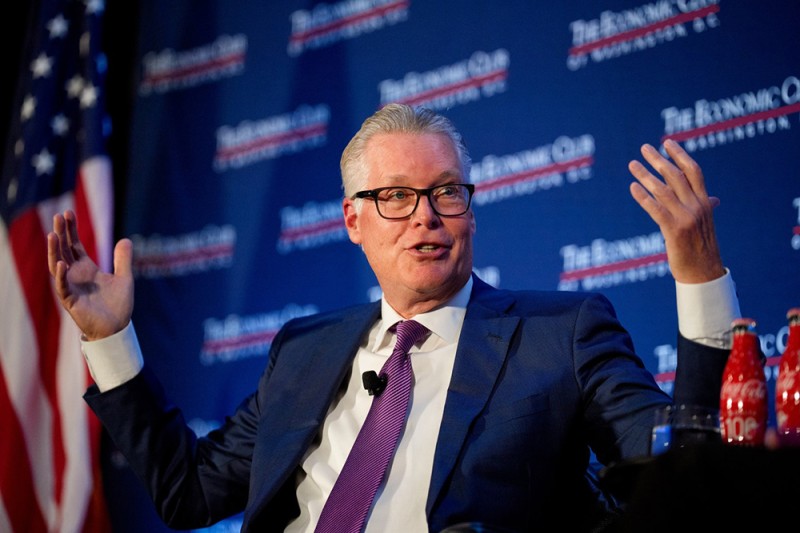
达美航空(Delta Air Lines)2025年第三季度财务业绩表现强劲,营收创下纪录并超出盈利预期,这主要得益于高端及商务旅行需求的持续坚挺。
首席执行官埃德·巴斯蒂安对未来数月表示乐观,预计全年调整后每股收益(EPS)将达到约6美元,处于此前指引区间的上限。展望2025年之后的未来,公司认为其战略定位有助于提高利润率、增加营收并把握高端旅行趋势。这家美国最盈利航空公司的业绩凸显出乘客偏好明显向高端旅行倾斜。
达美航空预计,长期被视为奢侈品的高端舱位销售额将在公司历史上首次超越传统主舱,且这一里程碑将在2026年实现,比此前预期整整提前一年。达美航空总裁格伦·豪恩斯坦此前曾预测高端舱位销售额将在2027年超越主舱。在后续的分析师电话会议上,当被问及这一预测以及当前趋势是否意味着2026年即可实现时,豪恩斯坦给出了肯定答复:“我认为你会看到。”
主舱需求的"转折点"
在业绩电话会议上,豪恩斯坦与首席执行官埃德·巴斯蒂安均谈及他们眼中的主舱需求“转折点”:本季度高端舱位(含头等舱和舒适经济舱)营收增长9%至近58亿美元,商务旅行则强劲反弹8%。与此同时,主舱销售额下降4%至约60亿美元。达美航空预计,这一消费行为转变趋势将加速。根据行业预测,高端舱位销售额有望在2027年前超越经济舱销售额。在截至9月30日的三个月里,达美航空报告调整后营收为152亿美元,调整后每股收益为1.71美元,两项数据均轻松超越华尔街预期。
高端需求激增与美国财富高度集中的态势直接相关。穆迪分析(Moody's Analytics)的数据显示,2025年第二季度,美国前10%的家庭贡献了总消费支出的近50%。首席财务官丹·詹基将业绩归功于达美航空削减非高峰航线、聚焦高利润航班的战略举措,但豪恩斯坦以近乎惊叹的语气描绘当前的趋势:“高端产品曾经持续亏损,如今却成为利润率最高的产品。”
达美航空的业绩报告推动其股价飙升6%,使其成为周四标普500指数中表现最佳的成分股之一。对韧性旅行需求的信心及达美航空强劲的执行力,带动航空板块普遍上涨。分析师指出,达美航空的业绩是美国航空业基本面改善的风向标,其乐观前景缓解了对经济放缓的担忧,并彰显了通过战略运力管理和聚焦高端细分市场可实现的盈利能力。
加倍投入高端领域
展望未来,豪恩斯坦表示他认为达美航空“未来几年将在高端领域看到更多机遇”。他列举了达美航空在洛杉矶、波士顿、纽约和西雅图的投资,视其为增长平台,因为“这些区域蕴藏着巨量高端客源。达美航空历史上在这些市场的渗透度远不如今”。
豪恩斯坦指出,达美航空不仅深耕中上层阶级聚居(及集散)的东西海岸,更“通过机场设施、达美至臻商务舱贵宾室(Delta One)等打造跨代际体验”。达美至臻商务舱贵宾室是随着达美飞凡贵宾室(Delta Sky Club)日益拥挤而推出的超高端贵宾室。豪恩斯坦补充道:“我们看到高端领域持续保持着可观的发展势头。”换言之,若达美航空的业绩确如表面所示具有指标意义,那么前10%的富裕群体将持续消费,并可能很快突破消费经济总量的50%。
达美航空未立即回应置评请求。(*)
译者:刘进龙
审校:汪皓
达美航空(Delta Air Lines)2025年第三季度财务业绩表现强劲,营收创下纪录并超出盈利预期,这主要得益于高端及商务旅行需求的持续坚挺。
首席执行官埃德·巴斯蒂安对未来数月表示乐观,预计全年调整后每股收益(EPS)将达到约6美元,处于此前指引区间的上限。展望2025年之后的未来,公司认为其战略定位有助于提高利润率、增加营收并把握高端旅行趋势。这家美国最盈利航空公司的业绩凸显出乘客偏好明显向高端旅行倾斜。
达美航空预计,长期被视为奢侈品的高端舱位销售额将在公司历史上首次超越传统主舱,且这一里程碑将在2026年实现,比此前预期整整提前一年。达美航空总裁格伦·豪恩斯坦此前曾预测高端舱位销售额将在2027年超越主舱。在后续的分析师电话会议上,当被问及这一预测以及当前趋势是否意味着2026年即可实现时,豪恩斯坦给出了肯定答复:“我认为你会看到。”
主舱需求的"转折点"
在业绩电话会议上,豪恩斯坦与首席执行官埃德·巴斯蒂安均谈及他们眼中的主舱需求“转折点”:本季度高端舱位(含头等舱和舒适经济舱)营收增长9%至近58亿美元,商务旅行则强劲反弹8%。与此同时,主舱销售额下降4%至约60亿美元。达美航空预计,这一消费行为转变趋势将加速。根据行业预测,高端舱位销售额有望在2027年前超越经济舱销售额。在截至9月30日的三个月里,达美航空报告调整后营收为152亿美元,调整后每股收益为1.71美元,两项数据均轻松超越华尔街预期。
高端需求激增与美国财富高度集中的态势直接相关。穆迪分析(Moody's Analytics)的数据显示,2025年第二季度,美国前10%的家庭贡献了总消费支出的近50%。首席财务官丹·詹基将业绩归功于达美航空削减非高峰航线、聚焦高利润航班的战略举措,但豪恩斯坦以近乎惊叹的语气描绘当前的趋势:“高端产品曾经持续亏损,如今却成为利润率最高的产品。”
达美航空的业绩报告推动其股价飙升6%,使其成为周四标普500指数中表现最佳的成分股之一。对韧性旅行需求的信心及达美航空强劲的执行力,带动航空板块普遍上涨。分析师指出,达美航空的业绩是美国航空业基本面改善的风向标,其乐观前景缓解了对经济放缓的担忧,并彰显了通过战略运力管理和聚焦高端细分市场可实现的盈利能力。
加倍投入高端领域
展望未来,豪恩斯坦表示他认为达美航空“未来几年将在高端领域看到更多机遇”。他列举了达美航空在洛杉矶、波士顿、纽约和西雅图的投资,视其为增长平台,因为“这些区域蕴藏着巨量高端客源。达美航空历史上在这些市场的渗透度远不如今”。
豪恩斯坦指出,达美航空不仅深耕中上层阶级聚居(及集散)的东西海岸,更“通过机场设施、达美至臻商务舱贵宾室(Delta One)等打造跨代际体验”。达美至臻商务舱贵宾室是随着达美飞凡贵宾室(Delta Sky Club)日益拥挤而推出的超高端贵宾室。豪恩斯坦补充道:“我们看到高端领域持续保持着可观的发展势头。”换言之,若达美航空的业绩确如表面所示具有指标意义,那么前10%的富裕群体将持续消费,并可能很快突破消费经济总量的50%。
达美航空未立即回应置评请求。(*)
译者:刘进龙
审校:汪皓
Delta Air Lines delivered a robust set of financial results for the third quarter of 2025, posting record revenue and beating consensus forecasts for earnings, driven largely by continued strength in premium and corporate travel demand.
CEO Ed Bastian expressed optimism for the months ahead, projecting full-year adjusted earnings per share (EPS) to reach about $6, at the upper end of previous guidance. The company sees itself strategically positioned to expand margins, grow revenue, and capitalize on premium travel trends as it looks beyond 2025. The results from America’s most profitable airline underscored a marked tilt in passenger preference toward premium travel.
For the first time in Delta’s history, the company now expects sales of premium seats—long seen as a luxury—will overtake those of its traditional main cabin offerings, and will do so in 2026, a full year earlier than previously expected. When asked on the subsequent call with analysts about his previous prediction that premium would overtake main in 2027 and whether these trends mean we can expect to see it in 2026, President Glen Hauenstein was positive: “I think you will.”
‘Inflection’ in main cabin demand
On the earnings call, both Hauenstein and CEO Ed Bastian discussed what they see as an “inflection” in main cabin demand, as revenue from high-end seats—including first class and comfort-plus—rose by 9% to nearly $5.8 billion in the quarter and corporate travel rebounded sharply, up 8%. At the same time, main cabin sales declined 4% to around $6 billion, signaling a shift in consumer behavior that Delta expects will accelerate, potentially allowing premium seat sales to overtake economy sales by 2027, according to industry projections. For the three months ended Sept. 30, Delta reported adjusted revenue of $15.2 billion, and adjusted EPS of $1.71, both comfortably ahead of Wall Street estimates.
This surge in premium demand is directly aligned with the dramatic concentration of wealth in the U.S., where the top 10% of households accounted for nearly 50% of all consumer spending in the second quarter of 2025, according to Moody’s Analytics. CFO Dan Janki referenced Delta’s strategic moves to trim off-peak routes and focus on more profitable flights as contributing to the results, but Hauenstein spoke almost in surprise at what’s playing out: “Premium products used to be loss leaders, and now they’re the highest-margin products.”
Delta’s earnings release sent its shares surging by as much as 6%, making it one of the top performers in the S&P 500 on Thursday. The airline sector gained broadly by association, boosted by confidence in resilient travel demand and Delta’s strong execution. Analysts point to Delta’s results as a bellwether of improving fundamentals in the U.S. airline industry, with its positive outlook assuaging concerns about economic slowdown and illustrating the profitability available through strategic capacity management and an elevated focus on premium segments.
Doubling down on premium
Looking to the future, Hauenstein said he thinks Delta is seeing “many, many more opportunities in premium in the coming years.” He cited Delta’s investments in Los Angeles, Boston, New York, and Seattle as a platform for growth, because “that’s where a considerable amount of premium lives. Delta historically wasn’t as big in those markets as we are now.”
And not only has Delta planted itself on the coasts where the upper middle class lives (and flies from), Hauenstein noted that Delta has “built generational experiences through the airports, the Delta One lounges,” referring to the extra-high-end tier of lounges that Delta has introduced as its Delta Sky Club lounges grow more overcrowded. “We see a considerable amount of continued momentum forward in premium,” Hauenstein added. In other words, the top 10% are going to keep spending, and maybe blow past 50% of the consumer economy soon, if Delta’s results are the bellwether they seem to be.
Delta did not immediately respond to a request for comment.

